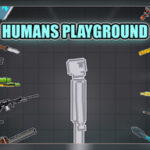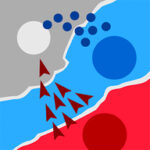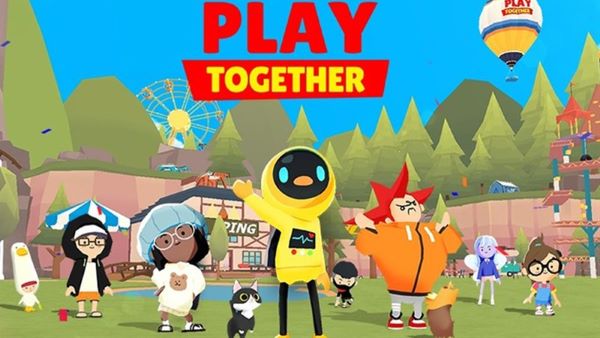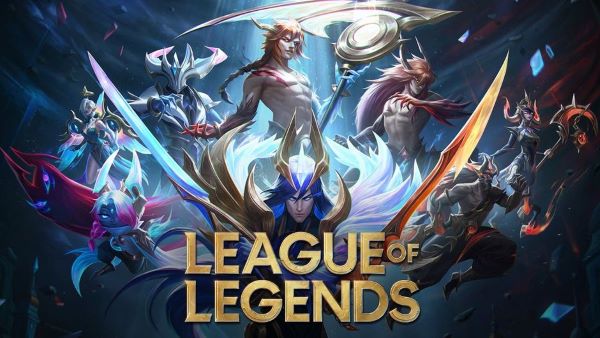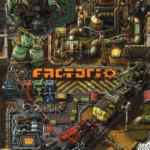Gorilla Tag isn’t just a VR game—it’s a phenomenon. Created by a solo developer under the name Another Axiom, Gorilla Tag exploded in popularity thanks to its simple but genius concept: players control gorillas with no buttons, only motion. There are no guns, no complicated rules, no leveling system—just a group of players jumping, climbing, and chasing each other using only their arms in immersive virtual environments. What began as a niche indie project has grown into one of VR’s most-played and most-discussed multiplayer experiences.
Part of Gorilla Tag’s magic lies in its movement system. Unlike most VR games that rely on analog sticks for navigation, Gorilla Tag forces players to move their virtual bodies by swinging their arms against the ground—just like an actual gorilla. This mechanic not only creates a unique sense of presence but also leads to one of the most active and physically engaging experiences in gaming. Add to that a thriving community, a suite of maps, and creative modes like tag, infection, and minigames, and it’s no wonder Gorilla Tag has built a loyal fanbase across Meta Quest, PC VR, and more.
1. The Birth of Gorilla Tag – Simple Idea, Massive Impact
Gorilla Tag was developed by Kerestell Smith (known as Another Axiom) and released in early access in 2021. At its core, the game’s premise is straightforward: players control gorilla avatars in VR and chase each other in modes like tag and infection. What makes it revolutionary is its movement. There are no sticks, no buttons, and no teleportation. You run, jump, and climb using only your arms.
Despite its basic graphics and minimalistic presentation, the game quickly went viral. Players on TikTok, YouTube, and Twitch began showcasing wild stunts, climbing tricks, and hilarious moments. Its low barrier to entry and emphasis on player interaction turned it into a playground not just for gamers but also for kids, families, and even educators exploring VR as a tool for physical activity.
2. The Movement System – Climb, Swing, Sprint with Your Arms
Movement is Gorilla Tag’s most iconic feature. Players swing their arms in real life to push off the ground and move their virtual gorilla avatars. You can climb walls, bounce between trees, and perform advanced maneuvers like pinch climbing and wall hopping. It’s intuitive but skill-based. New players can learn the basics in minutes, but mastering movement takes weeks of practice.
The game’s physics-driven locomotion system makes it one of the most physically immersive games in VR. Players report sweating, building stamina, and even improving their real-life upper body strength. Unlike games that simulate movement with a joystick, Gorilla Tag makes you feel like you’re actually running and jumping in a virtual jungle.
3. Game Modes – Tag, Infection, Paintbrawl and More
Gorilla Tag includes several game modes that all revolve around tagging and movement. Classic Tag mode is exactly what it sounds like: one player is “it” and chases others. Infection mode starts with one infected player who tries to tag others, slowly turning everyone until the last survivor is caught.
There’s also Paintbrawl, a newer competitive mode where players use slingshot mechanics to shoot at opponents while still using Gorilla Tag movement. This adds an extra layer of strategy and turns the game into a fun cross between tag and paintball. Players have also invented their own minigames like Ghost in the Graveyard and Monkey on the Shelf, creating a culture of community-driven fun.
4. Maps and Environments – From Forest to City
Though Gorilla Tag’s visual style is low-poly and minimal, its maps are cleverly designed and constantly updated. The original Forest map is a fan favorite with trees to climb, caves to explore, and hiding spots everywhere. Other environments include Canyon, City, Caves, Mountain, and Clouds—each with distinct layouts and movement challenges.
The City map functions as a social hub and store, while Mountain offers fast slides and verticality. The Caves map provides echo-filled tunnels and eerie hiding spots. New maps and seasonal themes (like snow and Halloween) keep the game fresh and visually dynamic despite its basic aesthetic.
5. Cosmetics and Customization – Express Yourself
Though Gorilla Tag doesn’t use traditional progression systems, it features a cosmetics shop where players can personalize their gorilla with hats, glasses, badges, and seasonal outfits. These items are purely cosmetic and do not affect gameplay, but they give players a sense of identity.
Players earn shiny rocks (the in-game currency) over time or by purchasing them. Cosmetics include silly items like banana hats, chef aprons, sunglasses, and even full costumes during special events. Seasonal cosmetics are limited-time, which adds value and encourages participation in holiday-themed events.
6. Community and Social Experience
Gorilla Tag thrives on community interaction. With no weapons or objectives, the game lives and dies by player behavior. Voice chat is proximity-based, so you hear players near you. This leads to spontaneous conversations, coordinated teamwork, trash talk, and hilarious moments. It’s like a digital jungle gym where the fun comes from human connection.
The game has attracted a wide age range, from young kids to adults, which brings both positives and challenges. Some servers may feel chaotic or noisy, but many players form lasting friendships, clans, and even fan-made roleplay servers. Gorilla Tag’s social nature makes it a warm, chaotic, and often hilarious multiplayer experience.
7. Accessibility and Free-to-Play Success
Gorilla Tag is one of the most accessible VR games available. It’s free to play on Meta Quest and SteamVR, requires no buttons to play, and runs on a wide range of VR hardware. Its file size is small, and sessions can be as short or long as the player desires.
The game’s success has also led to one of VR’s most impressive player counts. At peak times, tens of thousands of players are online across platforms. Gorilla Tag has proven that you don’t need photorealistic graphics or massive budgets to create a hit game—just a fun idea executed well.
8. Updates, Mods, and Developer Support
Another Axiom continues to support Gorilla Tag with regular updates, seasonal content, new maps, cosmetics, and gameplay tweaks. Holiday events like Halloween and Christmas bring themed items, decorations, and surprises. Community feedback heavily influences development, making it a player-focused game.
Modding is also a big part of Gorilla Tag’s ecosystem. While mods are only officially supported on PC, the community has created thousands of custom maps, textures, and tools. Mods can transform Gorilla Tag into entirely different games, like obstacle courses, horror maps, or competitive arenas.
9. Physicality, Exercise, and Real-World Impact
Gorilla Tag stands out in VR for its physicality. It’s not just a game—it’s a workout. Players use their arms, shoulders, and core muscles to move, climb, and sprint. It’s common to hear players say they’ve lost weight, improved cardio, or strengthened their upper body thanks to daily play sessions.
Educators and therapists have even begun exploring Gorilla Tag as a tool for fitness, coordination, and rehabilitation. The fact that it disguises exercise as play makes it an exciting new model for physical activity in the digital age. Parents appreciate that their kids are getting real movement while gaming.
10. Challenges and Growing Pains
Gorilla Tag’s biggest challenge is managing its diverse and often very young player base. Since the game is free and kid-friendly, it attracts players who may not follow etiquette or moderation rules. Some servers suffer from toxicity, loud chatter, or harassment. However, recent moderation tools, reporting systems, and server filters have helped improve the experience.
The game’s lack of structure can also be a double-edged sword. For players who enjoy goals, missions, or progression, Gorilla Tag may feel repetitive. It thrives on social interaction and physical motion rather than unlockables or achievements. But for many, this freedom is its biggest strength.
Conclusion – Gorilla Tag Is VR’s Wild Playground
Gorilla Tag is one of VR’s most original and influential games. It has no guns, no quests, and no objectives beyond movement and fun. Yet it offers some of the deepest engagement, most hilarious moments, and physically immersive gameplay in the entire VR space. Whether you’re chasing your friends through trees, dodging in Paintbrawl, or just hanging out in the City map wearing a pirate hat, Gorilla Tag always delivers chaotic joy.
Its movement system is revolutionary. Its community is lively. Its maps are clever and constantly evolving. And its influence on VR cannot be overstated. Gorilla Tag is proof that simplicity, physicality, and human interaction can create gaming magic—even without AAA graphics or big studio budgets. It’s not just a game. It’s an experience.
Final Overall Rating: 4.7 out of 5
Pros
Revolutionary motion-based movement system
Free-to-play with strong ongoing support
Highly active community and social gameplay
Physically engaging and good for exercise
Endlessly fun multiplayer moments
Cons
Can be chaotic with young or toxic players
No progression system or single-player goals
Limited appeal for players seeking structure
Mod support only official on PC
Gorilla Tag is not just one of the best VR games—it’s a new way to think about what games can be.















